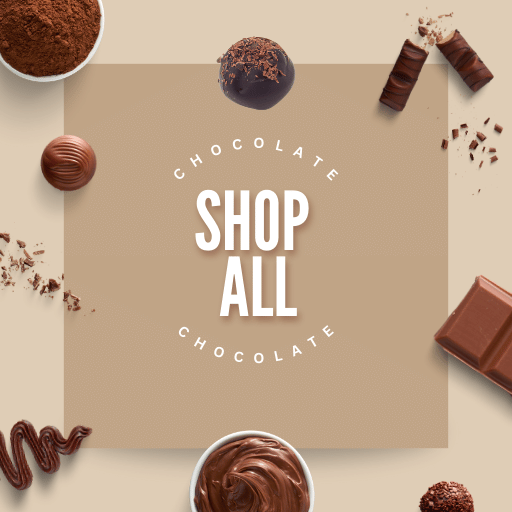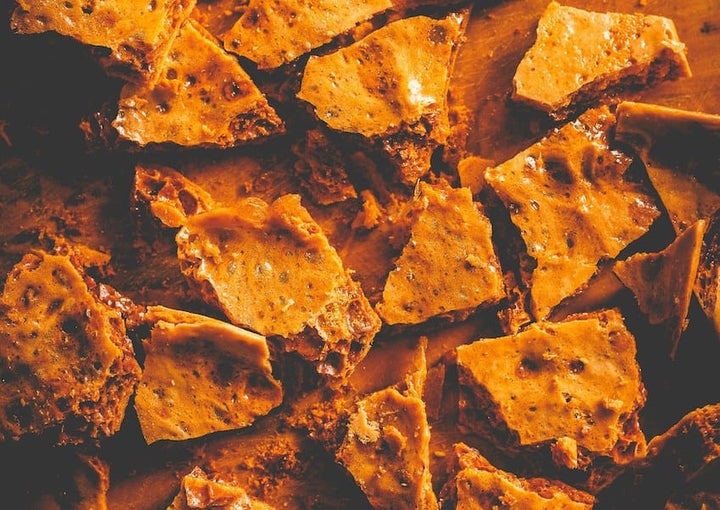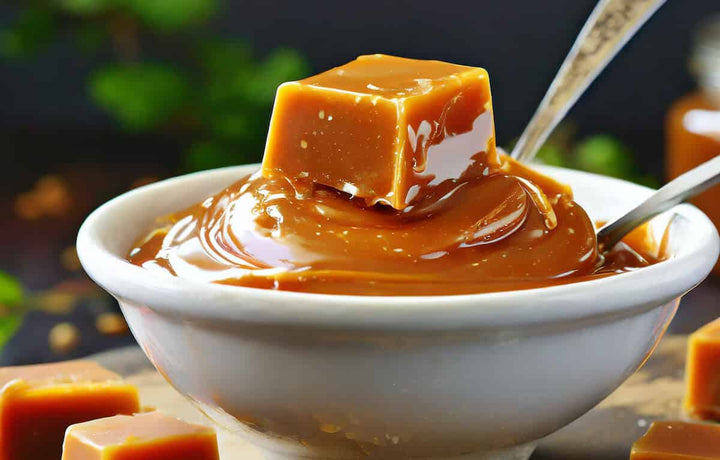Cinder toffee, a beloved treat known by various names such as honeycomb toffee, hokey pokey, or sponge toffee, stands out in the world of sweets for its unique texture and delightful taste.
This introduction invites you on a culinary journey to explore the intriguing world of cinder toffee, a confection that captivates with its airy, sponge-like structure and deep caramelised flavour.
In this post, we are going to explore what makes cinder toffee such a special sweet treat.
We'll explore its basic ingredients, the simple yet fascinating process of its creation, and the various ways it can be enjoyed, from being coated in chocolate to being crumbled over desserts.
What is Cinder Toffee?
Cinder toffee, also commonly known as honeycomb toffee, sponge toffee, or hokey pokey, is a light and crunchy confection with a distinctive honeycomb-like texture.
It's a popular treat known for its aerated, spongy structure and rich, toffee-like flavour that's both sweet and slightly burnt.
The key to cinder toffee's unique texture is the chemical reaction that occurs during its making.
The basic ingredients are typically sugar, golden syrup (or similar syrup), and baking soda.
Its taste is a delightful blend of sweet caramel with hints of a toasted, almost burnt flavour, characteristic of deeply caramelised sugar.
Cinder toffee can be enjoyed independently or coated in chocolate, complementing its sweet, crunchy nature.
It's also used as a topping or ingredient in desserts, adding a delightful crunch and flavour to ice creams, cakes, and other sweet treats.

What is the History of Cinder Toffee?
The history of cinder toffee, also known as honeycomb toffee or sponge toffee, is somewhat nebulous, with its exact origins being difficult to pinpoint.
However, this confection has been a popular treat in various parts of the world for many years.
Cinder toffee likely has its roots in the British Isles, where it has been a traditional treat for generations.
Its name “cinder toffee” is thought to come from its appearance, which resembles the cinders and coal used in traditional British fireplaces.
The treat's texture and taste, reminiscent of caramelised sugar, made it a favourite among people of all ages.
In the early days of confectionery, making toffee of any kind was a time-consuming and laborious process, often reserved for special occasions.
The introduction of bicarbonate of soda (baking soda) in the 19th century revolutionised the process, creating the unique, aerated structure that characterises cinder toffee.
When bicarbonate of soda is added to the caramelised sugar mixture, it reacts to form carbon dioxide gas, creating the toffee's distinctive honeycomb-like texture.
Over the years, cinder toffee has become a staple in various cultures.
It remains a beloved treat in the UK, often found at fairs and seaside resorts.
In Scotland, it’s known as "puff candy," while in New Zealand, it goes by the name “hokey pokey” and is a key ingredient in a popular ice cream flavour.
Cinder toffee's appeal lies in its simple yet delightful combination of crunchy texture and sweet, slightly burnt flavour.
How is Cinder Toffee Made?
Commercial production of cinder toffee, also known as honeycomb toffee or sponge toffee, involves a scaled-up and more precise version of the basic recipe used in home cooking.
While retaining the fundamental steps, the process is adapted for large-scale manufacturing, ensuring consistency, quality, and efficiency.
Here are the key steps in the commercial production of cinder toffee:
-
Ingredient Preparation: The basic ingredients remain largely the same - sugar, golden syrup (or a similar syrup), and baking soda. In a commercial setting, the quantities are significantly larger, and the quality of ingredients is carefully controlled to ensure a consistent final product.
-
Automated Cooking: The sugar and syrup are cooked in large industrial boilers or cookers. These machines are designed to handle large volumes and are often equipped with temperature control systems to manage the caramelisation process precisely. The mixture is heated until it reaches the correct temperature and colour, indicating that it has caramelised properly.
-
Adding Baking Soda: Baking soda is added once the caramelised sugar reaches the desired stage. This is a critical step where the baking soda reacts with the acidic components of the caramel, creating carbon dioxide gas. In commercial production, this step is carefully timed and executed to ensure that the gas is evenly distributed throughout the mixture, creating the characteristic honeycomb structure.
-
Cooling and Setting: The aerated toffee is then quickly poured into moulds or onto cooling belts. This process is often mechanised in a factory setting to ensure even spreading and thickness. The toffee is then allowed to cool and harden.
-
Cutting and Packaging: Once the cinder toffee has cooled and set, it is cut into desired sizes. This can be done using automated cutting machines. The final product is packaged, often in airtight wrapping to maintain its crispness and freshness.
-
Quality Control: Throughout the production process, quality control is paramount. Samples are regularly taken to ensure that the cinder toffee's texture, flavour, and appearance meet the set standards.
Commercial production of cinder toffee benefits from advanced equipment and technology, allowing for consistent and efficient production while retaining the traditional taste and texture that make cinder toffee a beloved treat.

How to Make Cinder Toffee at Home
Making cinder toffee at home is a fun and relatively simple process, though it requires careful attention to timing and temperature.
Here’s a basic recipe to create this crunchy, honeycomb-like treat:
Ingredients:
- 200g caster sugar
- 5 tbsp golden syrup
- 2 tsp bicarbonate of soda (baking soda)
Equipment:
- A heavy-bottomed saucepan
- A sugar thermometer (optional but helpful)
- A greased baking tray or a tray lined with baking parchment
Method:
-
Prepare the Tray: Grease a baking tray or line it with baking parchment. This is where you'll pour the hot toffee, so have it ready near your cooking area.
-
Combine Sugar and Syrup: In the saucepan, gently mix the caster sugar and golden syrup together. Try not to let the mixture climb up the sides of the pan.
-
Heat the Mixture: Place the saucepan on medium heat. Let the sugar dissolve completely into the syrup without stirring, which can take a few minutes. You can swirl the pan gently if needed to help it mix.
-
Boil to Caramelise: Turn up the heat and let the mixture boil once the sugar has dissolved. It will start to bubble and turn into caramel. This is where a sugar thermometer is handy - you’re aiming for the 'hard crack' stage, which is about 149-154°C. If you don’t have a thermometer, look for a rich golden-brown colour.
-
Add Bicarbonate of Soda: When the caramel is ready, quickly take the pan off the heat and immediately add the bicarbonate of soda. Stir it in briskly but briefly. The mixture will bubble up furiously, creating the honeycomb effect.
-
Pour and Set: Immediately pour the bubbly mixture into your prepared tray. Don’t spread or move it - just let it flow to fill the tray. Spreading can knock out the air bubbles that create the honeycomb texture.
-
Cool and Harden: Leave the toffee to cool and harden for about 1-2 hours. Don’t touch it during this time as it will be extremely hot.
-
Break into Pieces: Break the toffee into pieces once completely cooled and hardened. You can use a knife to score and snap it, or just tap it with a rolling pin.
Enjoy your homemade cinder toffee as it is, or for an extra treat, dip the pieces in melted chocolate and let them set before serving.
NOTE: Making cinder toffee involves working with very hot sugar, so take care, especially if children are helping.
What’s the Difference Between Honeycomb and Cinder Toffee?
The terms "honeycomb" and "cinder toffee" are often used interchangeably, and for good reason, as they essentially refer to the same sweet treat.
The difference between the two names is largely regional and historical.
"Cinder toffee" is a term more commonly used in certain parts of the UK, and the name is thought to derive from the confection's resemblance to the cinders and coal used in traditional British fireplaces.
"Honeycomb," on the other hand, is a name used more broadly and describes the confection's appearance, which looks similar to actual honeycomb structures found in beehives.
There is no significant difference between honeycomb and cinder toffee regarding ingredients, preparation, or texture.
Where Can You Buy Tasty Confectionery?
Whitakers Chocolates, renowned for our long history in crafting delicious and affordable chocolates, offers a range of options suitable for everyone, including vegetarian, vegan, and gluten-free choices.
Our top-selling products, such as indulgent Coffee Creams, Neapolitans, Chocolate Wafer Thins, Stem Ginger and Luxury Chocolate Truffles, are perfect for enhancing your mocha coffee experience.
Click here to see our delicious range of chocolate…
Some Notes From an Expert Chocolatier
One aspect I deeply apprecaite in my craft is blending different confectionery ingredients with fine chocolate to create unique and delightful treats.
This art of combination elevates the chocolate experience, adding layers of texture and flavour that entice and surprise the palate.
I find the incorporation of honeycomb or cinder toffee into chocolate to be a delightful endeavour.
The light, airy honeycomb crunch, with its deep caramel notes, contrasts beautifully with the smooth richness of chocolate, be it dark, milk, or white.
When these two elements come together, they create a symphony of textures and flavours - the melt-in-your-mouth creaminess of the chocolate paired with the crisp, sweet crackle of the honeycomb is a match made in confectionery heaven.
This combination is not only about taste and texture but also about creating a sensory experience.
The juxtaposition of the crunchy honeycomb against the chocolate makes each bite an adventure.
Whether in the form of a chocolate bar studded with honeycomb pieces or a truffle with a cinder toffee centre, the fusion of these elements is always exciting and innovative.
In my journey as a chocolatier, I've always been passionate about experimenting with such combinations, continually seeking ways to bring new and unexpected delights to chocolate enthusiasts.
Final Notes On Conder Toffee
Cinder toffee, also known as honeycomb or sponge toffee, is a delightful and unique confection that stands out for its light, aerated texture and rich caramel flavour.
Made from a simple combination of sugar, golden syrup, and bicarbonate of soda, it’s a testament to the marvels of culinary chemistry, where the right ingredients and precise timing result in a crunchy, honeycomb-like structure.
Cinder toffee's appeal lies in its contrasting textures – it’s hard to the touch yet dissolves pleasingly in the mouth, offering a sweet, slightly burnt, nostalgic, and indulgent taste.
Its versatility allows it to be enjoyed in various forms, from a standalone snack to an ingredient in a range of desserts, often coated in chocolate or crumbled as a topping.











